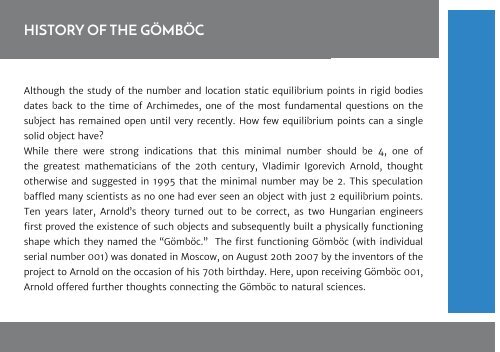gomboc_webshop_catalogue_ENG_watermark
Create successful ePaper yourself
Turn your PDF publications into a flip-book with our unique Google optimized e-Paper software.
HISTORY OF THE GÖMBÖC<br />
<strong>gomboc</strong>-shop.com<br />
Although the study of the number and location static equilibrium points in rigid bodies<br />
dates back to the time of Archimedes, one of the most fundamental questions on the<br />
subject has remained open until very recently. How few equilibrium points can a single<br />
solid object have?<br />
While there were strong indications that this minimal number should be 4, one of<br />
the greatest mathematicians of the 20th century, Vladimir Igorevich Arnold, thought<br />
otherwise and suggested in 1995 that the minimal number may be 2. This speculation<br />
baffled many scientists as no one had ever seen an object with just 2 equilibrium points.<br />
Ten years later, Arnold’s theory turned out to be correct, as two Hungarian engineers<br />
first proved the existence of such objects and subsequently built a physically functioning<br />
shape which they named the “Gömböc.” The first functioning Gömböc (with individual<br />
serial number 001) was donated in Moscow, on August 20th 2007 by the inventors of the<br />
project to Arnold on the occasion of his 70th birthday. Here, upon receiving Gömböc 001,<br />
Arnold offered further thoughts connecting the Gömböc to natural sciences.<br />
Although he did not live to know, Arnold was once again proven right, as the<br />
Gömböc’s shape already appeared to be deeply encoded into nature. Since then,<br />
the Gömböc not only became a symbol of the Hungarian innovation, but also as<br />
a widely recognised example of deep links between mathematics and the natural<br />
world.









